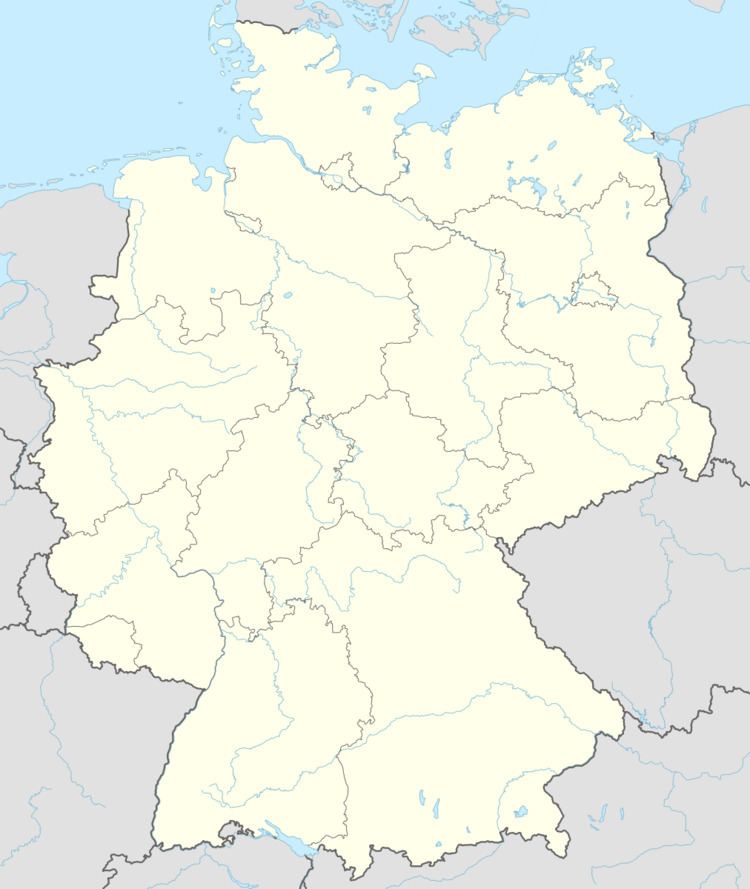Time zone CET/CEST (UTC+1/+2) Area 3.9 km² Population 454 (31 Dec 2008) Dialling code 06543 | Elevation 380 m (1,250 ft) Postal codes 55487 Local time Monday 9:43 AM Postal code 55487 | |
 | ||
Weather 6°C, Wind E at 11 km/h, 60% Humidity | ||
Niedersohren is an Ortsgemeinde – a municipality belonging to a Verbandsgemeinde, a kind of collective municipality – in the Rhein-Hunsrück-Kreis (district) in Rhineland-Palatinate, Germany. It belongs to the Verbandsgemeinde of Kirchberg, whose seat is in the like-named town.
Contents
- Map of Niedersohren Germany
- Location
- History
- Municipal council
- Mayor
- Coat of arms
- Buildings
- Other sites
- Theatre
- Via Ausonia
- Sport
- Regular events
- References
Map of Niedersohren, Germany
Location
The municipality lies in the central Hunsrück in the valley of the Sohrbach. The municipal area measures 3.90 km², 0.89 km² of which is wooded.
North of the village runs Bundesstraße 50, while to the south runs the historical Via Ausonia, a Roman road (called the Ausoniusstraße in German). Four kilometres northwest of Niedersohren lies Frankfurt-Hahn Airport. Niedersohren lies roughly 4 km southwest of Rhineland-Palatinate’s geographical midpoint. The cities of Mainz, Koblenz and Trier are more or less equidistant from Niedersohren.
History
Bearing witness to Roman settlement are graves found on the Via Ausonia and near the Annahof, where in 1884 fragments of a Roman grave memorial bearing a scene from daily life, and a cube-shaped quarrystone from the frieze of a second grave were unearthed. These are now found in the Museum Bonn.
In 1301, King Albrecht enfeoffed Eberhard von Sponheim with the village. The Counts of Sponheim held an estate in Niedersohren
In the 18th century, the Margrave of Baden was the landholder. Beginning in 1794, Niedersohren lay under French rule. In 1815 it was assigned to the Kingdom of Prussia at the Congress of Vienna. Since 1946, it has been part of the then newly founded state of Rhineland-Palatinate.
Municipal council
The council is made up of 8 council members, who were elected by majority vote at the municipal election held on 7 June 2009, and the honorary mayor as chairman.
Mayor
Niedersohren’s mayor is Helmut Karl, and his deputy is Jörg Schmitt.
Coat of arms
The German blazon reads: Gespalten durch eine eingebogene, gestürzte schwarze Spitze, darin ein rotbewehrter und- gezungter Adler, vorne in silber über einer blauen Schale ein blauer Krug, hinten in gold ein roter Schrägrechtsbalken.
The municipality’s arms might in English heraldic language be described thus: Tierced in mantle reversed, argent an urn and a bowl in pale azure, sable an eagle displayed Or, armed and langued gules and Or a bend of the fifth.
Niedersohren in the Pflege (literally “care”, but actually a local geopolitical unit) of Sohren was a royal estate, and thus the eagle is borne as a charge. In 1301, Niedersohren passed as an Imperial fief to the Counts of Sponheim, after whom came their heirs, the Margraves of Baden and the Counts of Veldenz. After the 1707 partition, the Margraves of Baden were the only landholders. The red bend (slanted stripe) in the gold field on the sinister (armsbearer’s left, viewer’s right) side refers to them. The two vessels on the dexter (armsbearer’s right, viewer’s left) side are from the Hunsrück-Eifel Culture and were recovered from a barrow in the municipal forest, district 6.
Buildings
The following are listed buildings or sites in Rhineland-Palatinate’s Directory of Cultural Monuments:
Other sites
Standing in the village centre is the Altes Backes (“Old Bakehouse”) which now houses the volunteer fire brigade. To its right stands a newer building, the municipal building.
Some 2 km from the village centre, between Niedersohren and Dill, is found a replica of a watchtower from Roman times, as well as a shelter cabin with “Roman games”. Looking from the Roman tower, there is a good view of the Idarkopf (one of the Hunsrück’s highest mountains) and Frankfurt-Hahn Airport.
Theatre
Since 2004, Niedersohren has been home to the only youth theatrical group in the Verbandsgemeinde of Kirchberg, the “Pina Coladas”. In 2010, the play “Doktor Deiwel − Was kann ich für Sie tun?” was performed.
Via Ausonia
Running by the replica watchtower and the shelter cabin is the Via Ausonia (locally, the Ausoniusstraße). This road, or rather path, was laid out by the Romans and saw heavy use in antiquity. The Via Ausonia leads from Bingen to Trier.
Sport
The Niedersohren sport club has been in existence since 1921. The sporting ground lies right on Kreisstraße (District Road) 2, going towards Sohren. There is also a youth football pitch.
There is a playing collective between the two sport clubs TUS Sohren and TUS Büchenbeuren.
